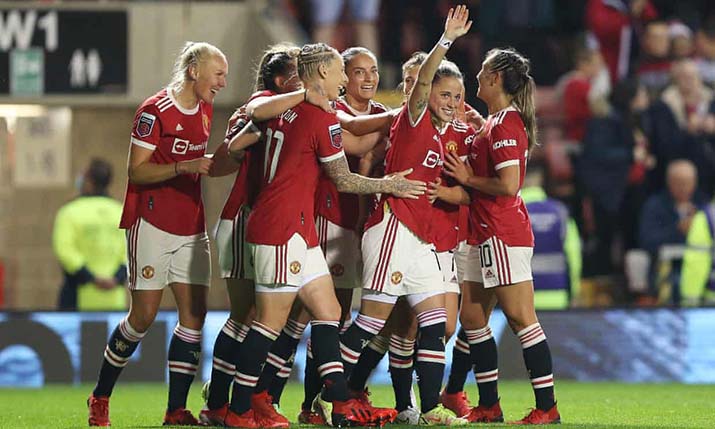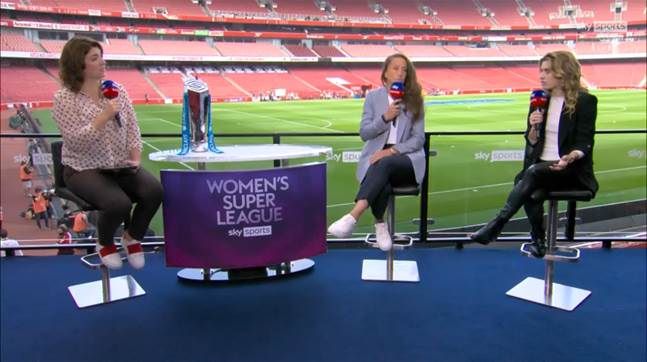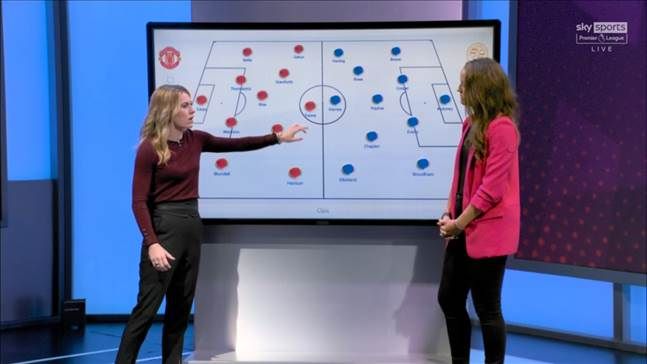Equal opportunities: Sky Sports on taking its Women’s Super League broadcasts to Premier League levels

The Women’s Super League is now on Sky Sports, which is ‘normalising’ the game by upping the broadcast production and coverage to English Football League and Premier League levels
Following the Football Association’s (FA) first standalone commercial broadcast deal for the Women’s Super League (WSL) earlier this year, Sky Sports is creating never-seen-before coverage of the top tier of women’s football.
The FA awarded a three-year contract to Sky Sports in March, starting from the current season of WSL. The deal marks the first time the women’s game rights have resulted in the league and clubs making money in this way, significantly helping to boost the league.
“It’s really important for me to provide the same level of content, the same quality of broadcast, the same entertaining stories, the same editorial lines, and not just for our current Sky audience, but for a new audience, but also more importantly for the league and for the growth of women’s football and women’s sport”
Sky Sports is showing 44 WSL matches per season across 22 match slots for the duration of the contract, plus an additional 13 games to be selected at its discretion. The BBC has 22 games, so one per match round broadcast live on free-to-air TV. Any remaining matches not selected for broadcast by the BBC or Sky are being shown live on the FA Player streaming service.
Speaking to SVG Europe about Sky Sport’s aims for the WSL, Jennie Blackmore, the broadcaster’s head of production for football and boxing, says: “We’ve got a big commitment to women’s sport in general. We’ve invested a lot of money and facilities in the netball that we’ve been doing over the last couple of years, and The Hundred, so any opportunity for us to take on more women’s sport, we have been wanting to grab. The Women’s Super League also obviously ties in really nicely with all the rest of our football rights. [We have an] ever-increasing pool of pool of football rights and it’s something from a strategy point of view, from a production point of view, and from a content point of view that a lot of thought was put into.”
Nia Wyn Thomas, senior producer for Sky Sports football on WSL, notes that the FA is dedicated to working with both Sky Sports and the WSL clubs to improve coverage of the women’s game. This includes the roll out of new connectivity at every stadium concerned prior to the beginning of the season to allow Sky Sports to enhance the broadcast, use remote production, and be more sustainable in its strategy.
Thomas comments that Sky Sport’s approach is more marathon than sprint: “This is not a Cup Final; this is a three-year deal where we’ve got at least one game every single match round. It’s about normalising WSL through the broadcast quality of this sport, and [doing that by] providing the same level of content and facilities and cameras angles, and chat and analysis [as for our other football coverage].
“It’s really important for me to provide the same level of content, the same quality of broadcast, the same entertaining stories, the same editorial lines, and not just for our current Sky audience, but for a new audience, but also more importantly for the league and for the growth of women’s football and women’s sport.”

Sky Sports is giving the Women’s Super League the same treatment as its top men’s football, producing it in UHD HDR, increasing camera facilities on site to the level of its other football coverage, and increasing analysis tools
All-star treatment
To make sure the WSL got the all-star treatment, Sky Sports held Sky Labs sessions around it to develop the strategy for the game. Says Blackmore: “From the moment we had the rights there were lots of Sky Labs sessions, which is where people come together from all parts of the business to say, ‘how do we want to make this content bigger and better than it’s ever been before?’ That involves lots of different ideas from all parts of the business, not just content teams. [We ask] how we can get more eyeballs on this new strand.
“Watching women’s football is still entertaining; you can easily relate to a WSL player because on Instagram they are very social, they’re very outgoing; they socialise amongst themselves, teammates, the opposition, and there’s no showiness”
“One way [we decided to do this is by] making [WSL] in the same way that we make the rest of our football, not differentiating; producing it in UHD HDR, increasing camera facilities on site to the level of our other football coverage, increasing analysis tools that are used. Just not differentiating between the level of coverage between the women’s and the rest of our football; giving it the Sky Sports feel, let’s say,” adds Blackmore.
Thomas says: “From our point of view, football has always been football. And I think also from the Sky point of view, [WSL] was the missing piece of the puzzle. WSL was the one thing that Sky didn’t have with regards to domestic football, and now you’ve got Premier League, English Football League’s (EFL) League Cup, there’s International, there’s Scottish football. It all kind of builds quite nicely into that portfolio of football that Sky has got.
“I think there’s been a misconception that women’s football isn’t very good, so by putting it front and centre and by putting it on Sky and by normalising it and putting it on Sky Premier League, Sky football on Main Event on Sky Showcase, which was Sky One, it’s there. If it’s there, people will watch it, because if you are a football fan, you will watch football,” Thomas adds.
Pulling in new fans
There are three key football fan types behind Sky Sports’ approach to WSL coverage. The first is the fan that genuinely likes watching football and that will watch and enjoy WSL through its normalisation alongside the Premier League and EFL. The second is to give the hardcore WSL fans the experience they have been waiting for, with, says Thomas, “the same level of coverage, more than one camera, and there’s proper analysis, there’s proper replays!”
She says that the third type of fan is one that is not necessarily an avid follower of the men’s game, but that may watch high quality coverage of the women’s game due to the players’ relatability and the lack of pretension, when compared to the Premier League.
“We’re creating the production from scratch every single game, pretty much. The work-arounds that [my team] have to come up with are far greater than for clubs that are used to OB trucks pulling up and cabling being [connected to a] plug up point in the compound”
Thomas explains: “You’ve also got an audience who may not necessarily like football that much. When you look at Premier League football, I think sometimes you look at players on the men’s side and you can’t relate to them because they are on extortionate amounts of money – and rightly so, because it’s a completely different product – but watching women’s football is still entertaining; you can easily relate to a WSL player because on Instagram they are very social, they’re very outgoing; they socialise amongst themselves, teammates, the opposition, and there’s no showiness [to them].”
However, adds Thomas, there was some pushback from a few Sky Sports subscribers at the beginning of the 2021 WSL season: “There has been, especially at the start, a few kind of negative comments on social media, people saying, ‘I’m going to cancel my subscription’. Why would anybody want to cancel a football subscription just because women’s football is on? If you don’t want to watch it, don’t watch it. But what we have seen is that lots of people are engaging on social media, especially on our social media channels and platforms.”

Sky Sports uses the Piero touchscreen for sports graphic analysis, matching its use on coverage of the men’s game
Technical logistics
The logistics of making the WSL broadcasts work to the level that Sky Sports has decided to do them has taken considerable time and effort. The main reason for this is the sheer amount of kit that needs to be put into place at the stadiums for every single match, while trying to reach as sustainable and remote a broadcast as possible.
Says Blackmore: “We’re creating the production from scratch every single game, pretty much. We’ve put a very strong production team on [WSL] for that reason, because it’s setting up a contract from scratch. The work-arounds that [my team] have to come up with are far greater than for clubs that are used to OB trucks pulling up and cabling being [connected to a] plug up point in the compound. [For these WSL stadiums we’re talking about] cabling that has to be run all around the stadium – physically pulled in – plus scaffold platforms, which is always very difficult with the clubs [as they] want to maximise seating, smaller gantries where [the clubs] also need to get their own analysis position in, or that there isn’t the infrastructure or the space for one. It’s very hard logistically.”
Blackmore states: “We have a set camera number [for all WSL games] that we aim for on level with our EFL coverage. We use steady cams and super slows, and this Piero touchscreen that we have been using on football league and Premier League as well, to give it that same level of exposure and level of analysis and coverage as the rest of our football.”
Blackmore continues: “It does depend on the ground, but using scaffolding and working together with the ground, you can still get the same 18 yard positions. There’s always a way round getting those positions in; just because they’re not built into the Premier League infrastructure, like they are for the big grounds, there’s still always a way that our team works directly with the FA and each ground to make sure that we can get that coverage.”
However, she adds that there are challenges in this coverage ambition for the Sky Sports teams: “For my production team point of view, there there’s a lot of work involved in this strand for that reason; that the clubs aren’t necessarily as set up and hardwired and have fixed positions, so it’s a lot of work for my production managers and production coordinators to make sure that we have that level of coverage, that the commentators have the best view possible, and that we’re sort of showing off the grounds to the best of our ability.”
Thomas: “The volume of work that goes on behind the scenes just to get into a good position, to be able to televise a match, is something. I think also it was a lot harder than I think lots of people [at Sky Sport were] anticipating because for Premier League or EFL, you just turn up and you plug in and the infrastructure’s there every single time. We’re putting demands on clubs and stadiums. I think it’s a learning process for everybody to understand the infrastructure that has to go on behind the scenes. It’s like setting up at Wimbledon; the huge amount of work that goes on just ahead of a two week a tournament; imagine doing that on a weekly basis? And it’s not as if we can just kind of leave everything there; there has to be a full de-rig as well.”
Adds Thomas: “[Sky Sports’ teams] are incredible, their dedication working with not only the WSL teams, but the stadium teams or the clubs, to say this is what we want. It is a three-year contract and we’ve hit the ground running, working with every single club to ensure that we’re showcasing them. The dedication from Jenny’s team and the work that has gone on behind the scenes [to make these broadcasts work] is stunning.”
Growing the women’s game
Sky Sports is committed to helping grow the women’s game. “That’s what’s really important,” says Thomas. “Working with the FA and working with the clubs to increase that visibility of women’s football.”
Thomas says: “It’s also important for us to remember that this isn’t a new product. The WSL is an established league. Women’s football is established, but [what we’re doing is] just about bringing the same level of coverage, the same camera angles, the same directors, the same production team, to WSL. We don’t have a director that’s just dedicated to the WSL; we have a lead [football] director who is worked very hard behind the scenes, especially in the build up to the start of the season, to make sure that the set and the graphics was all fine, and we have assistant producers, directors, vision mixers, the EVS operators and gallery technicians that work across football, regardless if it’s men or women, regardless of if it’s EFL or Premier League. I think it was really important to Sky to grow the game. It’s an amazing, lovely environment. It’s a great product.”
Adds Thomas on making sure the quality of the women’s game broadcast is the same as for all Sky Sports football: “It’s not just from a production base, it’s also from an editorial point of view; we have pundits, [both] male and female, that can cross over [into the women’s game], who can quite easily talk about women’s football as well as they can for men’s football. We were very keen at the start to ensure that our [talent] line up was very [high profile], and wanting to ensure that women, journalists, presenters and reporters and pundits, have now got the opportunity to work on women’s football on a more regular basis, but also to make sure that our commentators, Seb Hutchinson, for example, can work across Premier League, EFL, and women’s football, so there is no difference.
“I’m just delighted that we can do what we want to do to showcase just how football is football, regardless of who’s on the pitch,” Thomas goes on. “It’s really important that everyone involved is so passionate about it. We had eight assistant producers in the gallery working on the WSL analysis recently and they’re saying, ‘oh my god, this is great’. They’re discovering players; they’re on this journey with us. All of a sudden you get messages saying, ‘did you see that? Did you see that score?’ so that’s a new audience within this building, in the gallery.”
Boosting viewing figures
Thomas says that as a result of the efforts Sky Sports has put into evolving the WSL, viewing figures are up for compared to last year. She puts that down in a large part to the scheduling of the women’s game: “WSL is a completely different product [to our other football rights]. It’s a different viewing experience. It’s important to differentiate and ensure that it’s not a carbon copy of what [the Premier League or EFL is] doing. We have had some really good viewing figures, and it’s important also when we’re scheduling shows and our live coverage as well, when we come off the back end of a Sky Premier League game, for example, there’s a nice link and there’s that kind of cross promotion. It’s all to do with scheduling and having a dedicated slot [for WSL games]. I’m working with the FA to ensure that we work with all 12 clubs so they’re aware [of their slot].”
Thomas concludes that from a players point of view, based on conversations she had with players preseason, “they just wanted to be able to say to friends and family, ‘yeah, we’re on Sky, this is when you’ll see us,’ so that the schedule didn’t move around too much’.”
Football fans both in the UK and abroad will be excited to see how Sky Sports continues to push its coverage of the women’s game over 2022 and beyond.
